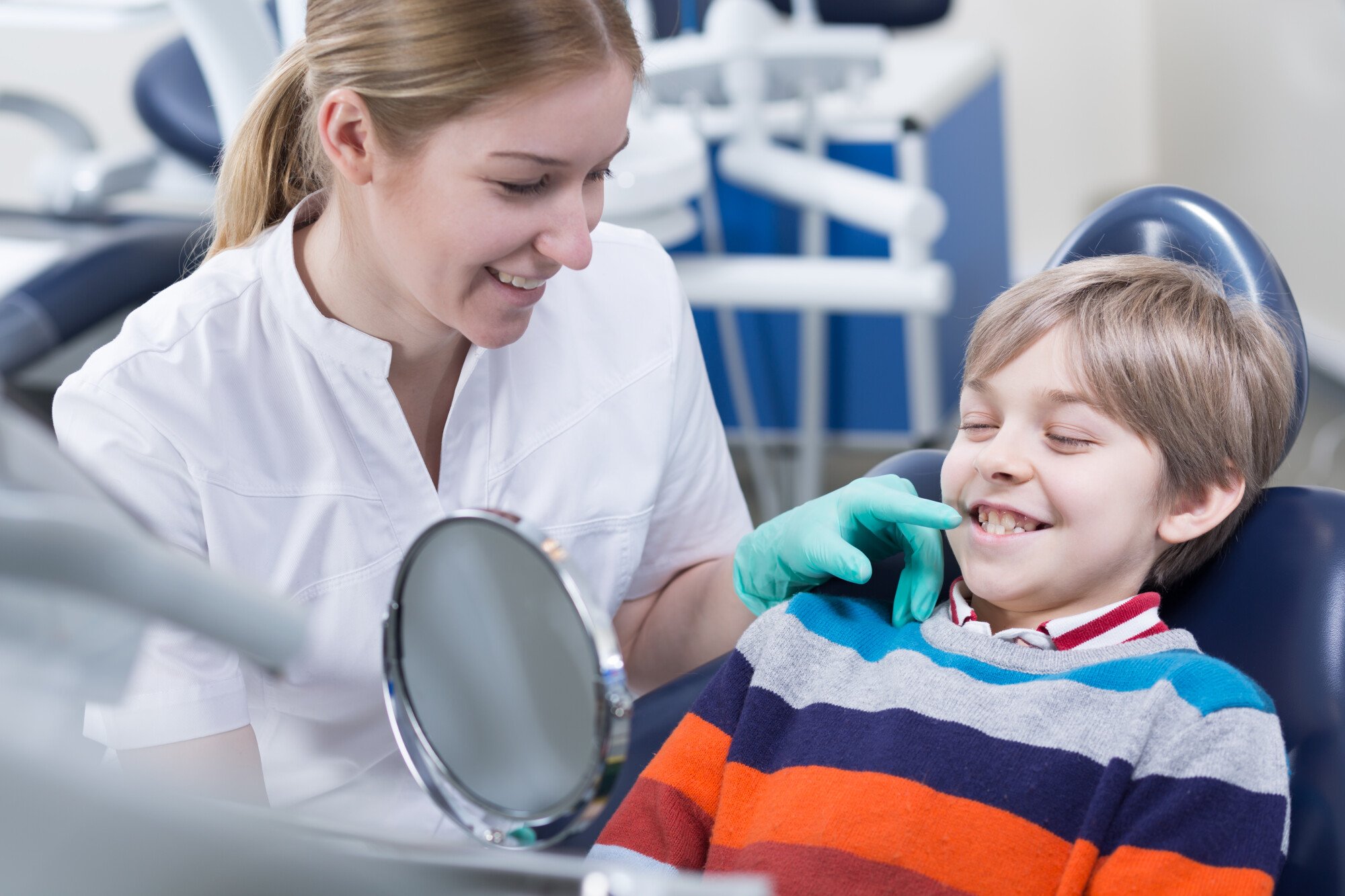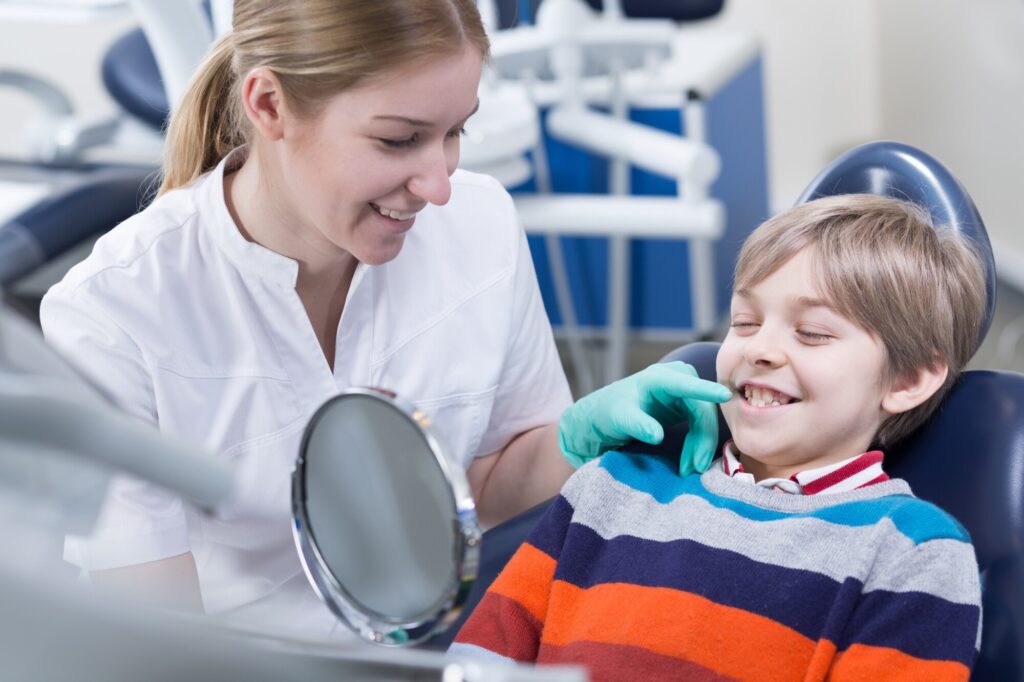Imagine your child playing happily, and suddenly, there’s a fall, a cry, and a broken tooth. This jarring scenario is all too common in households. It starkly illustrates the unpredictable line between regular dental care and urgent dental emergencies.
Each year, countless children face dental emergencies. This makes it crucial for parents to understand the difference between regular and emergency pediatric dentistry. This knowledge not only helps in providing timely care but also in averting panic during stressful situations.
In this article, we dive deep into what constitutes regular dental care. We’ll also look at what situations warrant immediate emergency attention.
With clear examples and guidance, we aim to equip you with the essential knowledge to make informed decisions about your child’s dental health. Knowing when to rush to the dentist and when to schedule a regular checkup can make all the difference in your child’s oral health journey.
So without further ado, let’s begin!
What Constitutes Regular Pediatric Dental Care?
When we talk about regular pediatric dental care, we’re focusing on the routine, the preventative, and the everyday steps taken to ensure your child’s oral health is on track. Think of it as the groundwork for a lifetime of healthy smiles.
Regular care includes routine dental checkups, which are far more than just a quick look at your child’s teeth. These checkups are comprehensive exams where dentists scrutinize teeth and gums, searching for any early signs of issues like decay or misalignment. It’s during these visits that small problems are caught before they escalate into bigger, more painful issues.
But regular care isn’t just about what happens in the dentist’s chair. It extends to the daily habits you encourage at home.
Teaching your child the importance of brushing twice a day, flossing regularly, and eating a tooth-friendly diet plays a massive role in maintaining oral health. Think of these practices as the armor that protects your child’s teeth from decay and disease.
Moreover, regular pediatric dental care is a journey that starts early – ideally with the first tooth. Early visits to the dentist acclimatize your child to the dental environment, reducing fear and anxiety.
These visits are also crucial for parents. They provide an opportunity to learn about proper oral care techniques for children, discuss concerns, and get professional advice on handling common issues like teething or thumb-sucking. In essence, regular pediatric dental care sets the stage for a lifetime of healthy teeth and gums, paving the way for your child’s oral well-being.
Recognizing Pediatric Dental Emergencies
What exactly is a pediatric dental emergency? It’s any situation where your child needs immediate dental attention.
This could range from a severe toothache to a tooth that’s been knocked out or broken. Knowing what constitutes a dental emergency is crucial for any parent. It’s about understanding when to act fast and when to wait for a regular appointment.
Injuries to the mouth and teeth are common in children, and not every injury requires a rush to the emergency room. However, certain signs should trigger an immediate response. For instance, if your child is in severe pain, has a tooth that’s loose or out of alignment, or experiences significant bleeding from the mouth, these are clear indicators that urgent care is needed. A quick response in such situations can prevent further damage and even save a tooth.
Infections are another critical area of concern. If your child has swelling around a tooth, a fever, or an unusual rash around the mouth, these could be signs of infection that need urgent attention. An untreated dental infection can rapidly worsen, leading to more severe health issues.
Understanding the types of pediatric dental emergencies is about more than just reacting to accidents. It’s also about being able to identify less obvious signs of oral distress.
Sometimes, what seems like a minor issue can escalate quickly. For example, a small chip in a tooth might not seem urgent, but without prompt treatment, it could lead to infection or further damage to the tooth.
The Types of Emergencies Your Child Might Face
Pediatric dental emergencies can come in various forms, and understanding these types is essential for any parent. One common emergency is a knocked-out tooth.
If your child’s tooth gets knocked out, quick action is necessary. Finding the tooth, holding it by the crown (not the root), and trying to reinsert it gently into the socket can be crucial steps before getting to the dentist. If you can’t reinsert it, keeping the tooth moist, either in milk or in your child’s saliva, is important while you seek immediate dental attention.
Chipped or fractured teeth are another common emergency. If your child chips a tooth, finding any broken pieces and rinsing them, along with your child’s mouth, with warm water is a good first step. Applying a cold compress can help reduce swelling while you contact your dentist.
Severe toothache is more than just a nuisance; it can signal a serious issue like an abscess or infection. If your child complains of significant pain, especially if it’s accompanied by swelling or fever, it’s time to see the dentist right away. Delaying treatment in such cases can lead to more severe complications.
Other emergencies include dental injuries resulting from sports or physical activities. Wearing protective gear like mouthguards can help prevent such injuries, but accidents still happen. In case of any injury to the mouth or teeth, it’s wise to consult a dentist immediately, even if there is no apparent damage.
The Role of Pediatric Oral Health
Pediatric oral health is a cornerstone of your child’s overall well-being. It’s not just about preventing cavities; it’s about laying a foundation for a lifetime of healthy habits.
Good oral health in children is crucial for their development, affecting everything from speech to nutrition. This is why regular pediatric dental care is so important. It helps maintain your child’s oral health, reducing the risk of dental emergencies.
Educating your child about oral hygiene from an early age is vital. This education includes teaching them about proper brushing and flossing techniques, the importance of a balanced diet, and the risks of sugary snacks and drinks. Remember, healthy habits formed in childhood are likely to continue into adulthood.
Regular dental visits are also key to pediatric oral health. These visits are not just for when problems arise; they’re essential for keeping problems at bay.
A pediatric dentist can spot early signs of issues like tooth decay or gum disease and take steps to address them. These professionals also provide valuable advice on preventing common dental problems and can help guide children in the right direction when it comes to taking care of their teeth and gums.
Furthermore, pediatric oral health is about more than just physical well-being. A healthy smile can boost your child’s confidence and self-esteem.
It’s heartwarming to see a child unafraid to smile because they’re proud of their teeth. This confidence can have a positive impact on their social interactions and overall happiness.
So, while the focus is often on treating dental issues, the real goal of pediatric dental care should be to prevent them. By prioritizing your child’s oral health, you’re not just caring for their teeth and gums; you’re setting them up for a healthier, happier future.
When to Seek Emergency Pediatric Dental Care
Knowing when to seek emergency dental care for your child can be a game-changer. In some situations, waiting for a regular appointment could worsen your child’s condition, while in others, immediate action is crucial. Here’s a guide to help you decide when it’s time to seek urgent care.
First, look for signs of severe pain. If your child is in extreme discomfort and unable to eat or sleep, it’s a signal that something serious might be happening. Pain is the body’s way of saying that something is wrong, and in the case of dental issues, it shouldn’t be ignored.
Bleeding that won’t stop is another red flag. A little bleeding after a baby tooth falls out is normal, but if the bleeding is heavy or doesn’t stop after applying gentle pressure for a few minutes, it’s time to seek emergency care.
Swelling in the face or gums can indicate an infection, which is a definite reason to see a dentist right away. Infections in the mouth can spread quickly and may become serious if not treated promptly.
Trauma to the teeth or mouth, such as a tooth that’s been knocked out or badly broken, also requires immediate attention. In these cases, time is of the essence to save the tooth.
Lastly, if your child has a loose tooth that’s causing discomfort, and it’s not a baby tooth ready to come out naturally, you should consult with a dentist as soon as possible.
Remember, in emergencies, acting swiftly can prevent further damage and ensure the best possible outcome for your child’s dental health. Don’t hesitate to contact your pediatric dentist or head to an emergency dental clinic if you suspect your child needs urgent care.
The Importance of Regular Checkups in Preventing Emergencies
Regular pediatric dental checkups play a crucial role in preventing dental emergencies. These routine visits are about much more than just cleaning teeth; they’re a proactive approach to your child’s oral health. During these checkups, dentists can identify and address potential issues before they turn into serious problems.
One key aspect of these checkups is the early detection of tooth decay. Cavities can develop quietly and, without symptoms, may go unnoticed until they cause pain or lead to more significant issues. Regular checkups allow dentists to catch these cavities early and treat them, often preventing the need for more extensive procedures.
Checkups are also a time for dentists to assess the growth and development of your child’s teeth and jaws. They can spot potential orthodontic issues, such as misalignment or bite problems, early on. Addressing these issues promptly can simplify treatment and sometimes even prevent the need for braces or other corrective procedures later.
Additionally, regular visits to the dentist help build a rapport between your child and their dental care provider. This relationship is vital in making your child feel comfortable and reducing dental anxiety. A child who is familiar with their dentist and dental procedures is more likely to be cooperative and less fearful during emergency situations.
In short, regular dental checkups are an investment in your child’s oral health. By maintaining these appointments, you’re not just keeping their teeth clean; you’re taking a significant step in preventing dental emergencies. Encouraging consistent oral hygiene habits at home and ensuring regular dental visits will go a long way in keeping your child’s smile healthy and bright.
Creating a Dental Emergency Plan
Having a dental emergency plan in place is crucial for any family. This plan should include the contact information of your pediatric dentist, an emergency dentist who handles after-hours cases, and your dental insurance details. Knowing exactly who to call and where to go in the event of a dental emergency can save precious time and reduce stress.
Teach your older children and caregivers about the plan, so they know how to react if you’re not around. Discuss different scenarios, such as what to do if a tooth is knocked out, and have a small dental first aid kit handy. This kit might include items like gauze, a small container with a lid for a knocked-out tooth, and saline solution.
It’s also a good idea to have a written plan posted in a visible place, like on the refrigerator. This can include step-by-step instructions on handling common dental emergencies until professional care is available. Being prepared can make a significant difference in how effectively you manage a dental emergency, ensuring the best possible outcome for your child’s oral health.
Emergency Pediatric Dentistry Explained
Understanding the difference between regular and emergency pediatric dentistry empowers you as a parent. It enables you to make informed decisions about your child’s oral health.
At Pinnacle Dentistry, we specialize in both regular and emergency pediatric dentistry. Dr. Jennings, Dr. Perrett, and our dedicated staff are here to provide excellent care for your child’s dental needs. In case of an emergency, contact us immediately for prompt, compassionate care. We ensure your child’s comfort and quick recovery in our Colorado Springs office.



